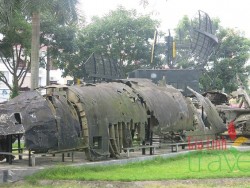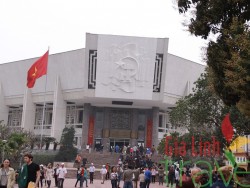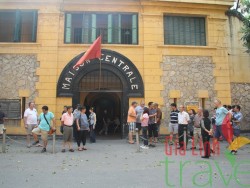Hanoi Museum
Hanoi Museum


Hanoi Museum

Hanoi Museum
Unless stated in any other case, museums are closed on Mondays
The Ethnology Museum (08.30 to 12.30, and 13.30 to 16.30)
Hanoi’s Ethnology Museum stands out as Vietnam’s best-managed cultural institution. Despite its location in the suburbs about a half hour’s drive from the city centre, it attracts streams of visitors.
Its subject matter is solely the 54 ethnic groups of Vietnam. The presentation of its intensive collection is imaginatively and effectively presented using dioramas, life-dimension models of people and reconstructions of dwellings, and carefully positioned video screens. The interpretation of each content and language is good.
A selected feature of the museum a number of full dimension buildings typical of selected ethnic minority groups, and a traditional Vietnamese family house, erected in attractive gardens. All are either authentic buildings which have been dismantled and reinstated at the museum, or have built by craftspeople from the villages themselves.
The History Museum (08.00 to 11.00, and 13.30 to 16.30)
Just behind the Opera Home, Hanoi’s History Museum offers a good overview of Vietnam’s history from prehistoric times to the tip of the Second World War. Although the arrangement of the reveals follows the standard chronological sequence, many of the individual artifacts are good quality.
However, in frequent with most museums in Vietnam, the Historical past Museum falls down on interpretation. A lot of the labels are in Vietnamese solely, and do little more than establish the objects to which they refer. There are few makes an attempt to put the articles in their context or to indicate their significance. Some showcases are filled with nearly identical exhibits.
In-built 1931 as a French cultural research and conservation establishment, the present-day museum carry on that tradition. The architecture is typical of the of the later French Colonial period that incorporated Vietnamese components to create a singular and impressive style.
The Museum of the Vietnamese Revolution (08.00 to 11.30, and 13.30 to 16.00)
Also housed in a colonial constructing, the Museum of the Vietnamese Revolution traces the trail in the direction of independence from the arrival of the French to reunification. The dominant medium is textual content, mainly newspapers and letters and thus is of less curiosity to the foreign visitor. The put up re-unification Vietnam is treated as a Shangri-la of milk, honey and blissful peasants, conveniently overlooking the horrors of hunger that stalked the land in these darkish days.
The Museum of Vietnamese Girls (08.00 to 16.00)
Often referred to as the Girl’s Museum, it deals with the contribution of ladies to Vietnam’s growth and notably their role within the conflicts of the last century.
It’s quite a gem in Vietnam’s cultural crown. Despite its small size and lack of assets, it has created a collection to put lots of the extra prestigious institutions to shame. It takes odd and infrequently mundane articles but places them in a context that vividly recreates the past. One pleasant touch is that of naming, and sometimes describing, the women who used them. An easy conceit, however one which personalizes the expertise immediately. Positively worth a visit!
The Ho Chi Minh Museum (08.00 to 11.30 and 14.00 to 16.30, closed Monday and Friday p.m.)
A large white building, innovatively -designed and constructed with Russian aid, homes Vietnam’s definitive museum dedicated to the life and times of the good leader. Documents, photographs, artifacts and tableaux are nicely designed to trace Ho’s passage from beginning to death and the evolution of his philosophy and vision for Vietnam’s future.
Unfortunately, almost everything is in Vietnamese and just a few of the museum staff communicate anything apart from their mother tongue, so a skilled guide fluent in your language is important to make sense of it.
Vietnam Military History Museum (08.00 to 11.30 and 13.00 to 16.30, closed Monday and Friday)
Formally the Museum of Navy Historical past, the Army museum is situated in the south-west nook of the Hanoi Citadel.
A large assortment of military paraphernalia clutters up the front gardens, balefully overlooked by a statue of Lenin on the opposite side of the road.
The principle exhibition covers occasions through the struggle in opposition to the French colonists from the 1930 rebellion to the victory at Dien Bien Phu in 1954. The American War is described in a separate exhibition stall.
Putting aside a strong propaganda factor, the rare photographs and video images of Ho Chi Minh, the legendary Common Giap, the battle of Dien Bien Phu and the Ho Chi Minh Trail makes a go to an unmissable experience for military historical past buffs in addition to those simply considering seeing the Vietnamese side of the conflict. Nonetheless, you’ll need a guide with you to assist with language and contextual interpretation.
A bonus is an opportunity to ascend the Cot Co Watch Tower adjoining to the museum. Apart from being of considerable interest as one of many few stays of Emperor Gia Long’s mighty edifice, the view from the top consists of the whole Citadel area and its surroundings.
The Nice Arts Museum (08.30 to 17.00 and 08.30 to 21.00 Wednesday and Saturday)
The fine colonial mansion that houses the museum was given an oriental-style roof when it ceased to be a residence. Nevertheless, the effect is pleasing.
The varied collections are eclectic – inevitably, the Soviet inspired social realism college is effectively represented however is under no circumstances dominant.
Among the many reproductions, there are some positive originals. Particularly word worthy are a delightful collection of folks artwork, and a good range of modern art including some wonderful water colors and modern contemporary work.
The Geological Museum (00.08 to 12.00, and 13.30 to 16.30 – closed Sunday)
This comprises an overview of the geology and geomorphology of Vietnam, and notably its many areas of mature limestone karst, corresponding to Ha Long Bay and Phong Nha. It’s worth a quick visit for general interest, however as it is mainly an analysis institution; the seemingly endless array of rock samples is hardly riveting for a lay person.
The Hoa Lo Prison (00.08 to 11.00, and 13.00 to 16.00 daily)
Generally known as the ‘Maison Central’ by the French and because the ‘Hanoi Hilton’ by US GIs, Hoa Lo is one of the three ‘must-see’ icons of the American Conflict, on a par with East Sea Seaside and the Cu Chi tunnels. Nevertheless, it’s also the one most likely to lead to disappointment. As soon as a massive French-built jail accommodating over two thousand prisoners at its peak, it became notorious as the non permanent home of large numbers of captured enemy troopers and airmen, principally American.
Nonetheless, during the Nineties, virtually all of the area was demolished to make approach for a modern tower block of flats and offices called the Hanoi Towers. On the south-east corner of the positioning, the doorway lobby and a few of the cells have been retained as a small museum.
Standing on the opposite side of the street, the building is dwarfed to insignificance by its huge neighbor, making it troublesome to think about its grotesque (and considerably exaggerated!) history. It contains a number of attention-grabbing displays, together with the heavily-used guillotine that was the centerpiece of the French judicial system in Vietnam, and is worth a visit. A guide is important, although, as only Vietnamese is used throughout.
The Truong Son Museum (08.00 to 11.30 and 13.30 to 16.30 each day)
Better often called the Ho Chi Minh Trail Museum, the Truong Son opened in April 1999 on a website about 13km from Hanoi by High manner 6, and has turned into popular with guests to Vietnam. The various artifacts, greater than 10,000 in response to the curator, are professionally presented, and are effective in illustrating the warfare time position of the engineers who constructed and maintained the trail. The reveals embrace an illuminated diorama of the trail clearly depicting its intricacy as it wound by means of Vietnam, Laos and Cambodia.
The Air Drive Museum (07.30 to 11.00 and 13.30 to 17.00 daily)
As Vietnam’s air drive was only established in 1959, most of the exhibits within the museum are concerned with the American War. Some are of interest, but as it’s located well outside the city centre, the Air Force Museum might be an attraction just for aficionados
